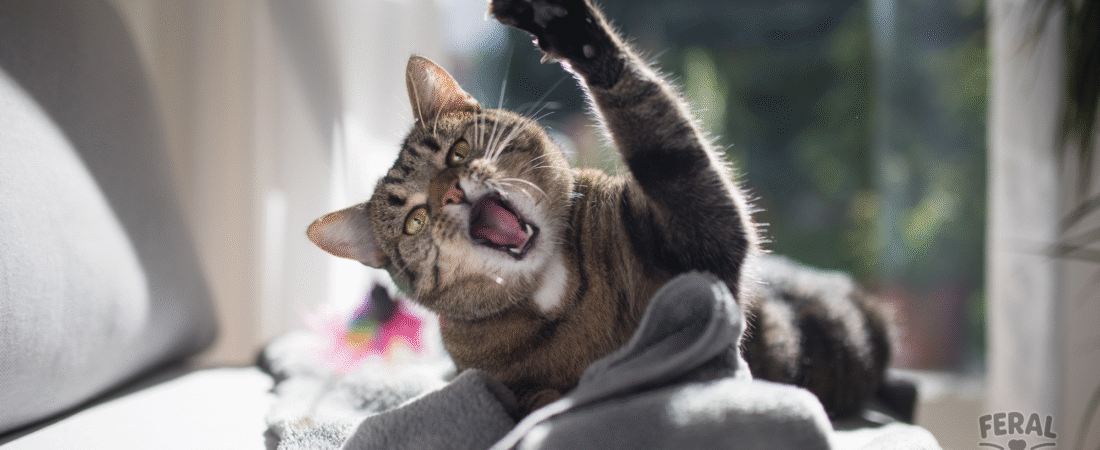📌 What Are the Cat Zoomies?

You know the drill: one moment your cat is peacefully napping, the next they’re a blur of fur, tearing through the house like a tiny, furry rocket. This sudden burst of frantic energy is affectionately known as the “zoomies,” or more formally, Frenetic Random Activity Periods (FRAPs).
- Definition: Short, intense bursts of high-speed running, jumping, and sometimes vocalizing, often without an apparent trigger.
- Common times: Often occur in the evening, early morning, or after using the litter box.
- Why it’s quirky: It’s a sudden, unpredictable transformation from serene feline to chaotic whirlwind, leaving owners both amused and bewildered.
👉 While it looks like pure silliness, there are often deeper reasons behind these sudden bursts of feline energy.
🦠 What Triggers the Zoomies?
Several factors can turn your calm cat into a furry blur:
1. Pent-Up Energy Release
- The main culprit: Cats are natural hunters, designed for short bursts of intense activity followed by long periods of rest. Indoor cats, especially, don’t always get enough opportunities to stalk, chase, and pounce.
- Result: This unspent energy builds up, and the zoomies are a way to release it all at once.
2. Post-Litter Box Euphoria (or Relief)
- Many cats get the zoomies immediately after a trip to the litter box.
- Theory 1: It’s a feeling of relief and lightness after a successful bowel movement.
- Theory 2: It’s an instinctual behavior to quickly escape the area after eliminating, to avoid attracting predators to their scent.
3. Overstimulation or Stress Relief
- Sometimes, a sudden loud noise, a new object, or even a stressful interaction can trigger a FRAP.
- Coping mechanism: The intense physical activity can be a way for cats to burn off adrenaline and cope with stress or anxiety.
4. Play & Hunting Instincts
- The zoomies can be a form of solo play, where your cat is imagining chasing prey.
- They might bat at invisible objects, pounce on shadows, or chase their own tail.
- This is especially common in kittens and younger cats who have an abundance of playful energy.
5. Attention Seeking
- If your cat learns that running around like a maniac gets your attention (even if it’s just a laugh or a shout), they might do it more often.
🚨 Are Cat Zoomies Normal or a Cause for Concern?
For most cats, zoomies are a normal, healthy outlet for energy.
- Normal: If your cat is otherwise healthy, eating well, and not showing signs of pain or distress, enjoy the show!
- When to be concerned:
- Excessive or frantic zoomies: If they seem distressed, disoriented, or are running into things.
- Associated with pain: If they suddenly start after an injury, or if they seem to be running away from a specific body part.
- Older cats: A sudden onset of zoomies in a senior cat could indicate pain (e.g., arthritis relief after resting) or even cognitive dysfunction.
👉 If you have any concerns, a vet check-up is always a good idea.
🌿 Holistic & Practical Management
You can’t stop the zoomies entirely (nor should you!), but you can help manage them and ensure your cat is happy and healthy.
- Scheduled Playtime:
- Daily interactive play with wand toys, laser pointers (end with a treat!), or feather teasers.
- Aim for two 15-minute sessions a day to mimic hunting cycles.
- This helps burn off pent-up energy in a controlled way.
- Environmental Enrichment:
- Cat trees, scratching posts, puzzle feeders, and window perches provide mental and physical stimulation.
- A stimulating environment reduces boredom, a common trigger for FRAPs.
- High-Quality Diet:
- A diet rich in animal protein and low in unnecessary carbohydrates provides sustained energy without the sugar spikes that can contribute to hyperactivity.
- Litter Box Hygiene:
- Keep the litter box spotlessly clean. A dirty box can cause stress, which might contribute to post-litter box zoomies.
- Calming Aids (if stress-related):
- Feliway diffusers or calming treats can help reduce anxiety in stressed cats.
❓ FAQs
Q1: Do all cats get the zoomies?
Most cats experience them, especially younger ones. Some are just more prone to it than others.
Q2: Is it bad if my cat gets the zoomies at night?
It’s normal, as cats are crepuscular (most active at dawn and dusk). Try to schedule intense play sessions right before bedtime to tire them out.
Q3: My cat runs into walls during zoomies. Is that normal?
Occasional bumps are common, but if it’s frequent or they seem disoriented, consult a vet.
Q4: Can zoomies be a sign of pain?
Sometimes. If a cat suddenly starts zoomies after an injury, or if an older cat develops them, it could be a sign of discomfort or a neurological issue.
💡 Final Thoughts
The cat zoomies are a charming, if chaotic, part of feline life. They’re a natural expression of your cat’s inner hunter and a vital way for them to release energy and manage stress.
✅ Key takeaway: Embrace the furry rocket! Provide plenty of interactive play and a stimulating environment, and you’ll have a happy, healthy cat who occasionally turns into a delightful blur.

